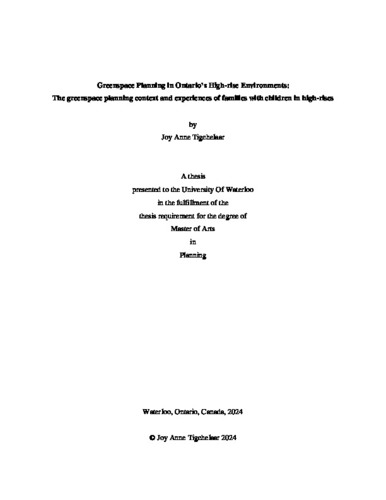| dc.description.abstract | Despite a growing number of families with children living in urban settings, cities remain largely unequipped to support families, particularly in high-rise settings that are marketed and designed towards singletons, young professionals, and the elderly. However, children remain a largely underrepresented population in municipal planning and very few researchers have investigated the experiences of families living in high-rises, including how they access and use greenspace. While a few studies from Australia have investigated families’ experiences in high-rises, there is no known published Canadian research that seeks to understand the experiences of high-rise families within Canadian communities. In response to these gaps, this thesis seeks to understand “how municipal planning in Ontario facilitates the creation of child-friendly outdoor greenspaces surrounding high-rise developments?” and “How do families with children living in high rises experience using and accessing their neighbourhood greenspace?” Respectively this thesis will respond to these questions through a policy analysis of Ontario municipal planning documents for a diverse set of communities and interviews with families living in high-rises within the Cities of Kitchener, Waterloo, and Cambridge, three urbanizing cities in Ontario. While few municipalities within this study considered the needs of children and families living in high-rises in their high-level planning documents, guidelines such as the Growing Up guidelines from the City of Toronto should inspire growing municipalities to begin considering the diverse populations that live in high-rise settings. Furthermore, based on the experiences of high-rise families, the ability to access and use their neighbourhood greenspaces is vital for play and socialization due to the spatial limitations of their dwelling, which is particularly constraining during winter months. Future municipal policy should consider these needs and future research should investigate the experiences of families in high-rises further through various methods and within different geographies to tailor planning approaches to local contexts. | en |

